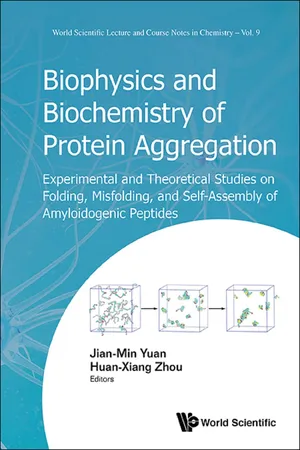
Biophysics And Biochemistry Of Protein Aggregation: Experimental And Theoretical Studies On Folding, Misfolding, And Self-assembly Of Amyloidogenic Peptides
Experimental and Theoretical Studies on Folding, Misfolding, and Self-Assembly of Amyloidogenic Peptides
Jian-Min Yuan, Huan-Xiang Zhou;;;
- 328 pagine
- English
- ePUB (disponibile sull'app)
- Disponibile su iOS e Android
Biophysics And Biochemistry Of Protein Aggregation: Experimental And Theoretical Studies On Folding, Misfolding, And Self-assembly Of Amyloidogenic Peptides
Experimental and Theoretical Studies on Folding, Misfolding, and Self-Assembly of Amyloidogenic Peptides
Jian-Min Yuan, Huan-Xiang Zhou;;;
Informazioni sul libro
-->
This book reviews current research on the important processes involved in neurodegenerative diseases (e.g. Alzheimer's disease) and the peptides and proteins involved in the amyloidogenic processes. It covers the design and developments of anti-amyloid inhibitors, and gives readers a fundamental understanding of the underlying oligomerization and aggregation processes of these diseases from both computational and experimental points of view.
--> -->
Contents:
- Preface
- Perplexity of Amyloid β-Protein Oligomer Formation: Relevance to Alzheimer's Disease (Brigita Urbanc)
- Exploring the Aggregation Mechanism of Intrinsically Disordered Tau Protein (Ruxi Qi, Guanghong Wei, Ruth Nussinov and Buyang Ma)
- Design and Application of Anti-Amyloid Peptide-Based Inhibitors as a Therapeutic Strategy of Alzheimer's Disease (Rita P-Y Chen)
- Statistical Mechanics and Kinetics of Amyloid Fibrillation (Liu Hong, Chiu Fan Lee and Ya Jing Huang)
- Kinetic Studies of Protein Aggregation With and Without the Presence of Crowders (John S Schreck, John Bridstrup and Jian-Min Yuan)
- Thermodynamics and Kinetics of Protein Folding and Aggregation (Min-Yeh Tsai, Jian-Min Yuan and Sheng Hsien Lin)
- Folding and Misfolding of Amyloid-β40 and 42 in Alzheimer's Disease (Yu-Jen Chang and Yun-Ru Chen)
- Single-Molecule Fluorescence Resonance Energy Transfer Studies of β-Amyloid Clusters in Physiological Solutions (Jun Han, Erwen Mei, Mei-Ping Kung, Hank F Kung, Jian-Min Yuan and Hai-Lung Dai)
--> -->
Readership: Graduate students and researchers studying the field of neurodegnerative diseases and interested in the chemical processes that occur.
-->Amyloid Peptide/Protein;Neurodegenerative Diseases;Alzheimer's Disease;Protein Aggregation;Protein Misfolding;Anti-Amyloid Inhibitors Key Features:
- Written by practicing experts in the field
- Provides the most up-to-date information of research in the field
- Both experimental and computational perspectives are covered
Domande frequenti
Informazioni
| Perplexity of Amyloid β-Protein Oligomer Formation: Relevance to Alzheimer’s Disease | 1 |
Philadelphia, PA 19104, USA
Faculty of Mathematics and Physics,
University of Ljubljana,
1000 Ljubljana, Slovenia
1.Introduction
1.1.Universality of protein aggregation
1.2.Intrinsically disordered proteins
1.3.What role do Aβ oligomers play in AD?
2.Aβ and AD: Cause and Effect?
Indice dei contenuti
- Cover
- Halftitle
- World Scientific Lecture and Course Notes in Chemistry
- Title
- Copyright
- Preface
- Contents
- Chapter 1. Perplexity of Amyloid β-Protein Oligomer Formation: Relevance to Alzheimer’s Disease
- Chapter 2. Exploring the Aggregation Mechanism of Intrinsically Disordered Tau Protein
- Chapter 3. Design and Application of Anti-Amyloid Peptide-Based Inhibitors as a Therapeutic Strategy of Alzheimer’s Disease
- Chapter 4. Statistical Mechanics and Kinetics of Amyloid Fibrillation
- Chapter 5. Kinetic Studies of Protein Aggregation With and Without the Presence of Crowders
- Chapter 6. Thermodynamics and Kinetics of Protein Folding and Aggregation
- Chapter 7. Folding and Misfolding of Amyloid-β40 and 42 in Alzheimer’s Disease
- Chapter 8. Single-Molecule Fluorescence Resonance Energy Transfer Studies of β-Amyloid Clusters in Physiological Solutions
- Index